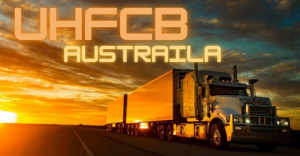
CB radio is intended to provide short-range radio communication for almost any purpose, business or personal. Equipment is inexpensive and there are no license fees to pay. There are two types of CB equipment: HF 27 MHz and UHF 477 MHz.
The ‘megahertz’ (MHz) refers to the radio frequency on which the equipment operates. 27 MHz is between the 530 – 1602 kHz AM and 88 – 108 MHz broadcast bands. 477 MHz is between the VHF (eg 2, 7, 9 & 10) and UHF (eg SBS 28) TV channels. Signals on different frequencies behave differently, and thus affect the performance of equipment.
The differences between 27 MHz and UHF are explained below. Information is also provided on deciding between the two and the limitations of CB communication.
27 MHz CB started in the United States in the 1950s and spread worldwide in the 1970s. Australia legalised CB in the late 1970s, following a vigorous campaign by truck drivers and others who wanted cheap, local communications for personal or business purposes. The government initially allocated 18 channels for CB. Operators had to obtain a government call sign, pay an annual licence fee and use type-approved equipment. However unlike amateur radio, no technical examination was required.
In Australia 27 MHz CB was planned as a temporary allocation, with users to move to UHF in five years. However it proved so popular that the band was extended to its current 40 channels in 1982. If you hear an inexperienced person talk about ‘CB’ the chances are that they are referring to 27 MHz.
Most CB operators did not bother with licensing. Provided you did not cause interference, used illegal amplifiers or make a nuisance of yourself, the chance of being caught by Department of Communications inspectors was slim. The cost of policing was probably higher than revenue foregone. This was recognised in 1994, when the government abolished CB licence fees. However operators must still use their equipment in accordance with the CB class licence, a copy of which is available on the Australian Communications and Media Authority website.
27 MHz is capable of both local and interstate communication. However the latter cannot be relied upon. What 27 MHz can do depends on the transmission mode (AM or SSB), with SSB providing better results when signals are weak and/or over long distances.
Locally, expect communication distances of between 5 and 15 kilometres on AM. Actual range achieved will depend on antenna efficiency, terrain and interference levels. Well-equipped home stations will do better than a mobile station. On SSB, distances of between 15 and 30 kilometres are common, with 3000 km sometimes possible under favourable conditions. Good conditions are often called ‘skip’, so-called because the signal bounces (‘skips’) off the ionosphere on its way to the other station. Long-distance propagation is most common in December/January each year and throughout the year during times of high sunspot activity.
Like 27 MHz, UHF CB also started in the 1970s. However unlike 27 MHz, UHF CB is unique to Australia. The 40 UHF channels were set up as an alternative to 27 MHz when government policy was that access to 27 MHz would only be temporary. Early UHF sets were expensive and not always reliable. The line-of-sight characteristics of UHF made it poor in hilly areas. As a result, UHF CB grew slowly for the first few years of its life.
Farmers were the first group to adopt UHF CB from the early 1980s. Farmers were soon joined by truck drivers and rural businesses wishing to take advantage of UHF’s crisp, clear signals. UHF is also popular amongst travellers on major highways throughout Australia, as it provides a useful means of calling for help or passing on road or weather warnings. In the cities UHF activity is a mixture of general chit-chat and business communications.
The main reason for UHF’s growth was the spread of repeater stations and improved (and cheaper) equipment. UHF CB has been so successful that it is now more active than 27 MHz in most places.
UHF CB uses the FM transmission mode. UHF gives clear, crisp local communication without the long-distance interference sometimes heard on 27 MHz. UHF is also less susceptible to power line noise than 27 MHz. Its main disadvantage is that it performs poorly in hilly and forested areas due to its ‘line of sight’ characteristics. Typical direct (simplex) car-to-car ranges of UHF vary between about 5 kilometres in urban areas to 20 kilometres or more in open countryside. However if located on a hilltop, distances of 50 kilometres are common, even with low-powered handheld equipment.
UHF really comes into its own when repeater stations are used. Repeaters are installed on hilltops and retransmit signals received on one channel onto another channel. They are set up by community groups or commercial organisations but can freely be used by everyone. Distances of 50 to 100 kilometres are commonly achieved via repeaters, even if mobile or handheld transceivers are used. Most urban and rural areas are served by at least one repeater. To listen for the repeaters in your area, search for signals between channels 1 and 8. Those channels are busy most of the time are likely to be repeaters.UHF CB Australia is funded by the generous donations from our supporters, Show your support and donate safely using PayPal and help keep these vital services going